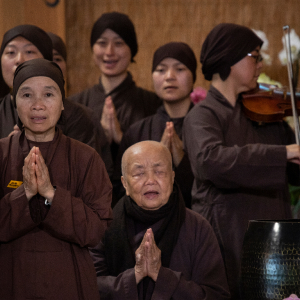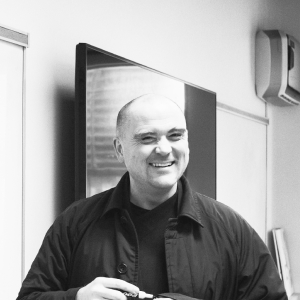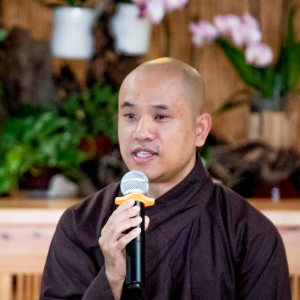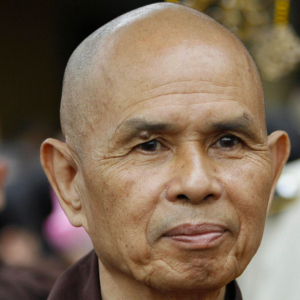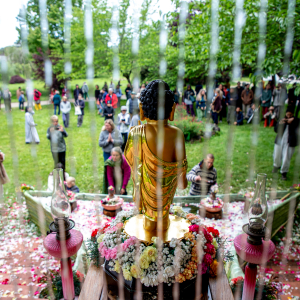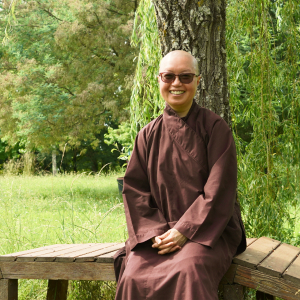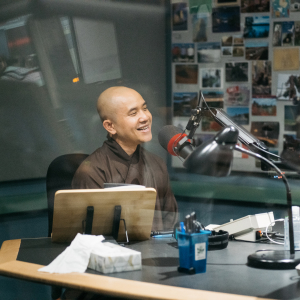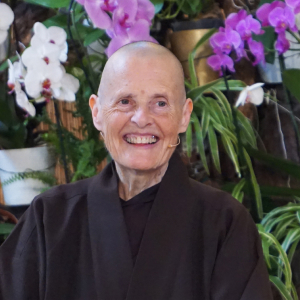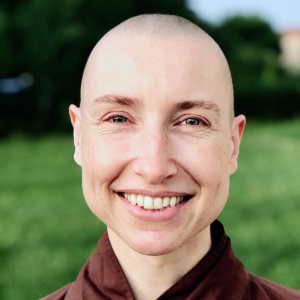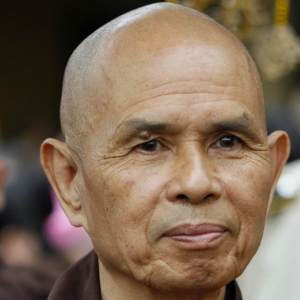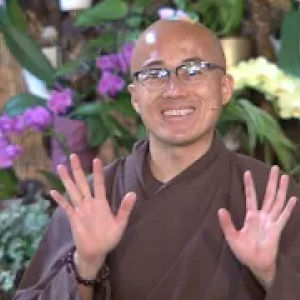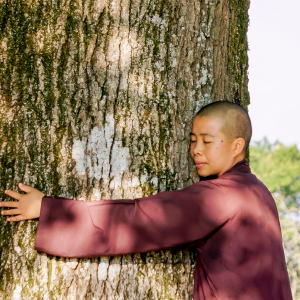Discover Listen
Listen

79 Episodes
Reverse
This Dharma Talk was recorded in Upper Hamlet, Plum VIllage France on 20th June 2023 during our Earth Retreat with the title “Love is Freedom”.
This Dharma Talk was recorded on the 6th of June 2023, in Lower Hamlet, Plum Village France, as part of the retreat “Finding our True Home”.
Thich Nhat Hanh answers questions during a retreat in Plum Village (May, 2014).
“Let the Buddha breathe, I don’t need to breathe”.
Can we take refuge in our Buddha nature when times are hard? If we can manage to find some peace within, we become a solid refuge for ourselves, our loved ones and the world.
this Dharma Talk was recorded on 11th May 2023 in the Upper Hamlet, Plum Village France.
“Compassion is the intention and the capacity to relieve suffering in the world.” This dharma talk was given on Thursday, 8 June in Upper Hamlet, Plum Village, during a retreat for young people who have grown up away from home.
Br. Thien Duc with music by Srs. Hien Tam & Hieu Duc This guided meditation was offered in Upper Hamlet, Plum Village (France) during the Climate Retreat in autumn 2023. Any place where you find yourself listening to this, can be your meditation hall :)
Where is our true home? Is it a particular place with particular people within a particular culture? What if we had to leave our “home”? Or lost the people we held most dear? Or grew up in a culture vastly different to that of our parents’? In this deeply moving talk, Sister Dinh Nghiem (“Adornment with Concentration”) shares her experience as a child of a refugee family, the death of her father, finding Thay as her teacher and touching peace in the practice of dwelling truly in the present moment. The talk was given as part of a themed retreat for young people of Asian heritage who were born or grew up in the west. __________________________________________________________________ this talk was recorded in Lower Hamlet, Plum Village France on 4th June 2023.
By becoming mindful of our emotions we can respond appropriately instead of reacting to a challenging situation. This is the art of mindfulness that we can cultivate in our daily life, to be the change we want to see in the world.
Freedom is possible with our mindful breathing and mindful walking.
Breathe in and focus your attention on your in-breath. Your in-breath becomes the only object of your mind, you are concentrated on your in-breath, you are mindful of your in-breath. You release the past, the future and your worries and you become a free person. If you want to keep that freedom, you can breathe out mindfully. Breathing out, you focus your concentration on your out-breath.
One breath can bring you home to ther here and the now. One step can also bring you home to the here and the now. From the parking lot to the office, you may like to walk in such a way that every step release the tension in your body. Every step bring you home to the here and the now so you can touch the wonders of life available in you and around you.
The seventh exercise of mindful breathing is to recognize the painful feeling in us. Breathing in, I am aware of the painful feeling in me. Breathing out, I smile to the painful feeling in me. The eighth exercise is to calm down the painful feeling. Mindfulness is like a mother holding the child of suffering. The first thing you do is to use the energy of mindfulness to recognize the painful feeling. The second thing is to use mindfulness to embrace the painful feeling tenderly.
Exercise five is to generate a feeling of joy. Exercise six is to generate happiness. A good practitioner can always generate a feeling of joy and happiness whenever he or she wants.
Help us caption & translate this video!
https://amara.org/v/DqWy/
on the 14th of June 2022, we had a wonderful music and poetry concert to celebrate 40 years of the Plum Village tradition. The concert was part of a two-week long mindfulness practice retreat, with the theme “Now We Have a Path, We Have Nothing to Fear”, held in Plum Village, France.
In the Sutra on the Eight Realizations of Great Beings, we read “the mind is always looking outside of itself and never feels fulfilled”. How can we overcome this constant running and come back to our true home? The obstacle to our peace of mind is our inability to dwell in the present moment. In this Dharma Talk, Sister True Virtue shares how we can practice the 4 establishments of mindfulness as well as the 16 exercises of mindful breathing in order to get out of the state of dispersion of our mind. Rather than trying to attain something, we can experience each breathing exercise with ease. If we give ourselves a chance to recognise and accept a painful feeling, we can be at peace. We also have the example of Ancestral Teachers who practiced being fulfilled in the present moment. Master Tang Hoi, King Tran Thai Thong, King Tran Nhan Thong, and Master Nhat Dinh, are all real examples of applied and engaged Buddhism. In the midst of a busy life, they were able to be at peace and share the practice with countless people.
Please enjoy the first Dharma Talk of the Plum Village Online New Year’s Retreat. Find out more about Sister True Dedication : https://plumvillage.org/people/dharma-teachers/sister-hien-nghiem/
Thich Nhat Hanh offers this dharma talk at Deer Park Monastery during the Colors of Compassion Retreat on March 25, 2004.
Letting go is not about suppressing or denying our experiences, but rather acknowledging and accepting them with compassion and understanding. By embracing impermanence and non-attachment, we can free ourselves from the burden of past regrets and future worries, and cultivate a deeper sense of peace and freedom in the present moment.
Brother Phap Dung, a senior monastic in the Plum Village Zen Tradition, explores these concepts further in this talk, providing guidance on how to cultivate the power of cutting off and letting go in our daily lives, and how it can contribute to our overall well-being and inner peace.
Before taking a deep dive into our suffering, practicing mindfulness according to the breathing exercises taught in the Anapanasati Sutta increases our capacity for happiness and joy. In this way, we are able to hold our deep suffering. Thay regularly taught his students to balance the spiritual life among the four spiritual pillars: work/service, practice, study, and play. Sister Trai Nghiem offered concrete examples of practicing the four pillars and posed these questions for us to ponder in our lives as mindfulness practitioners. How do we enjoy and create joy in our daily activities? How do we know if the work we are doing is supporting the purpose of our life? To end the Dharma Talk, Sr. Trang Tu Hieu and Sr. Trang Hien Tam offered the song “The Sun is Rising”, composed by Sr. Trang Tu Hieu.
The flower only exists if we are present for it. Life is miraculous. Only when we are present are we fully living. What are the things that stop us from fully living? It is our worries, fears, physical pain, regrets, shame, frustration … The practice of mindfulness helps us to not suppress difficult or strong emotions when they arise. This avoids creating internal knots that may become stronger over time. We learn to recognize our strong emotions, embrace them so the seeds in the depth of consciousness weaken. Only then are we able to clearly see the roots of suffering. When we practice together, we are building a community that, in the face of collective despair, is resilient. Through songs, poetry, and her precious moments with Thay, Sister Tại Nghiêm (Sister “Adornment with Presence”) inspires us to grow the seeds of mindfulness.
We all have aspirations, dreams, joys and sorrows deep in our hearts. But are we aware that anything we want to cultivate needs food to grow? In Buddhist psychology, we learn that there are four kinds of nutriments: edible food, sense impressions, volition, and consciousness. In terms of edible food, are we consuming in a way that sustains our health and nourishes our heart of compassion? As for sense impressions, do we take the time to develop friendship and bonding in our daily lives or are we constantly being hooked to our devices? Do we recognize the stress, intensity and addiction that spending so much time on our devices brings about for ourselves, our family and our society? When it comes to volition, we are speaking about our deep aspiration. What kind of aspirations do we pursue in life? The Five Mindfulness Trainings give us very clear and concrete guidelines on how to live our daily life with compassion and the insight of interbeing. We need the awareness and determination of every individual on Earth to reverse the process of global warming. The fourth kind of nutriment, consciousness, is both individual and collective. For us to be able to realize our potential, we need to be in a wholesome environment. With the practice and the sangha, we can generate mindfulness and love for us and others to take refuge in.
from 2022 11 03, Rains Retreat, Lay Day, Talk 7. How can we embrace our ancestors that we have never met? This and the below questions were addressed by Brother Phap Huu and Sister True Dedication in this “a-la-carte Dharma Talk”. * How can we understand our deep suffering from our store consciousness, especially circumstances inherited from our family? * How do I practice compassion and reconciliation when I’ve decided to cut ties or establish boundaries with family members? * What is the difference between letting go and giving up? * What are your experiences while meditating? * How to keep a balance between attachment and support in spiritual friendships? Did you know that even zen monks and nuns have boundaries and need to know their own capacities while practicing mindfulness in the sangha? Brother Phap Huu and Sister Hien Nghiem shared their personal experiences on the importance of having spiritual friendships, supporting one another on the path, and that by setting boundaries, we are compassionate to ourselves and love is more accessible for others when we are recharged. Acknowledging our capacities in our individual practice, we imagine ourselves sitting on a boat peeking at our suffering. We don’t need to go seeking for the sea monsters deep in the abyss of our store consciousness. With the practice of mindfulness, our suffering naturally arise from our store consciousness. When suffering or habits arises, we can be curious and ask “who are you?” Allowing us to be curious about which of our ancestors are present in us; whether or not we have met them. When we come to retreats, we think that we are going “alone.” In fact, we are bringing our whole family and ancestral lineage. If we are lucky, we will be renewed and have a deeper taste of what it means to be human.


